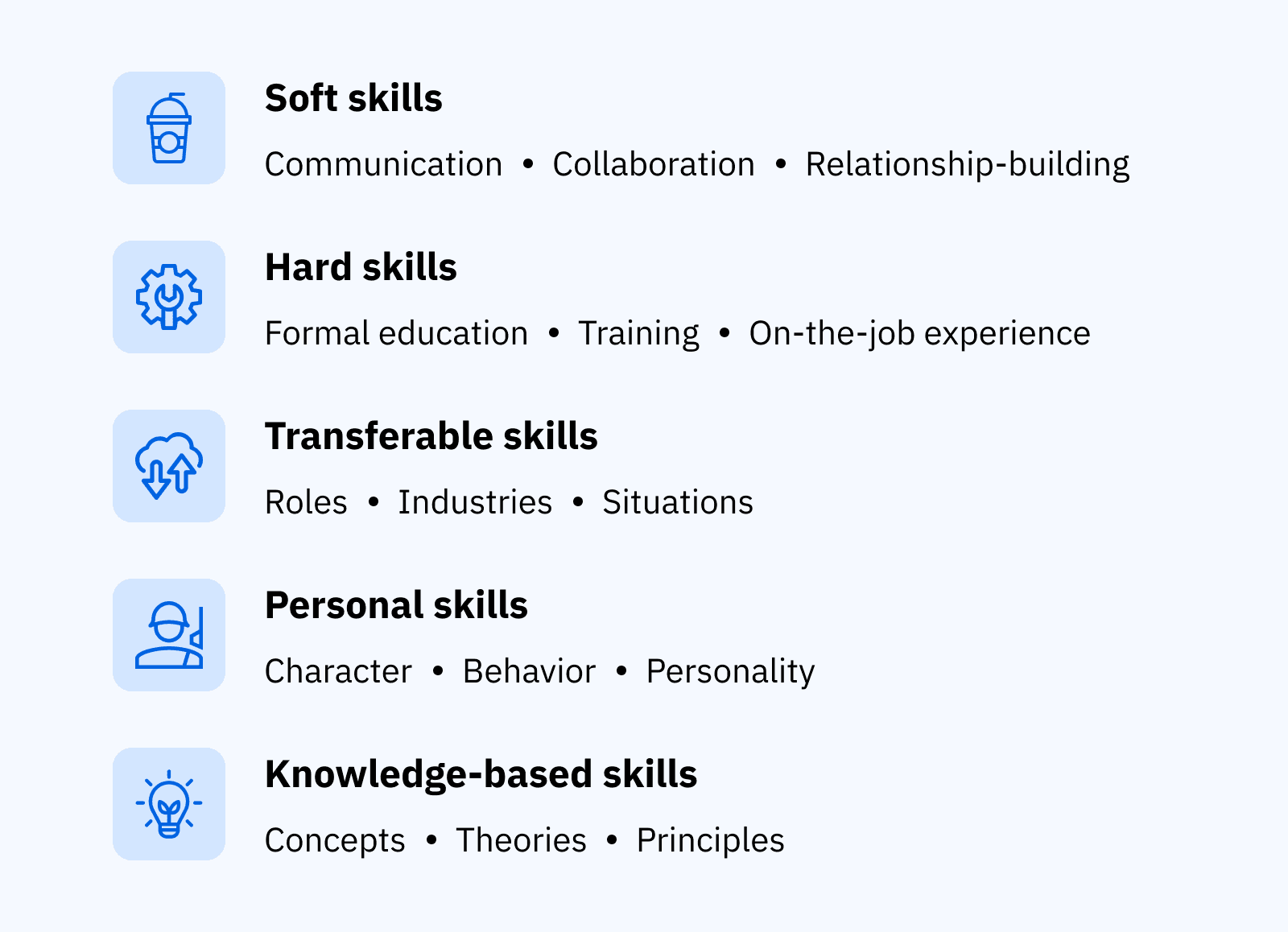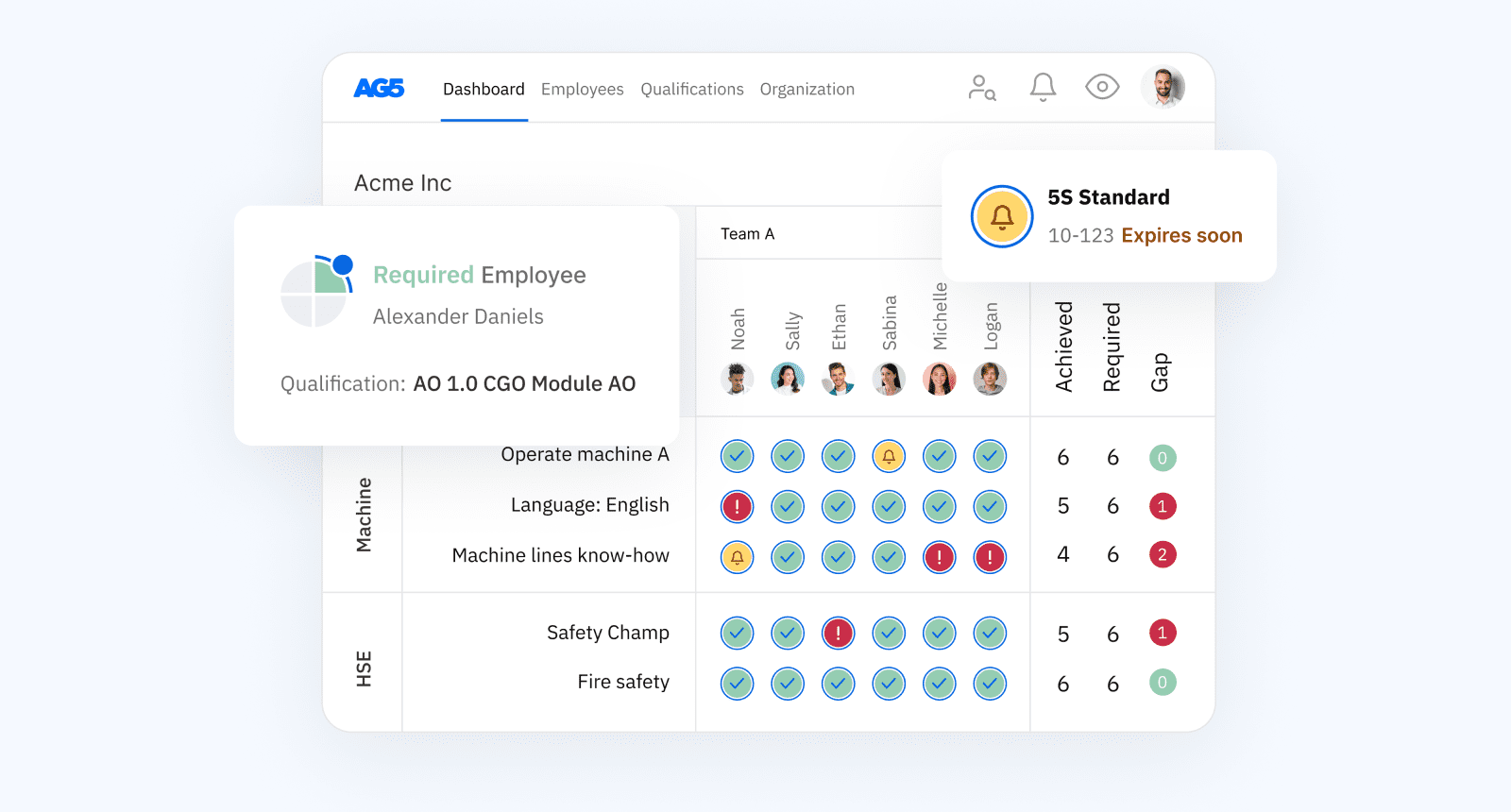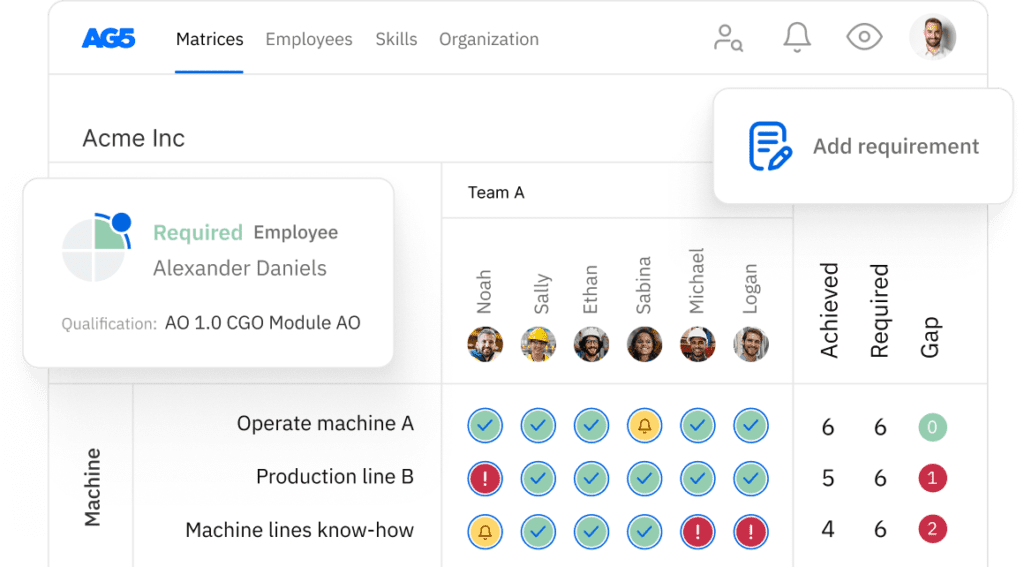What are skills? Explanations & examples
In this article, we are taking a look at the definition, hard vs. soft skills and how you can keep track of your teams skills.

The terms “skill” and “competence” are often used interchangeably, but there is an important difference. While a competence is a combination of knowledge, skills, and personality traits. This means a skill is only one of the elements that make up a competence.
In this blog, we’ll take a closer look at skills, their definition, skill types and examples, as well as how you can use AG5’s skills management software to easily track and manage them.
What are skills?Copied
A “skill” is an individual’s ability to perform a specific task or solve a problem at a high level of proficiency. [1]
They are acquired through:
- Education. Formal instruction from an educational or technical institute. Often, education is more theory-based
- Training. Targeted instruction or practice that is focused on a specific skill or skill set. Training is usually more practical than education
- Experience. The practical application of both training and education. Experience involves hand-on participation in real-world situations related to the skill or skill set
There are various types of skills. Let’s take a look at a few of those categories in the section below.
Different types of skillsCopied
Skills are diverse and can be categorized into various skill types. [2] Here, we’ve listed five broad categories of skills, as well as what they encompass.
Soft skills
Soft skills are those related to interpersonal and communication abilities. Typically, soft skills are non-technical, instead focusing on effective:
- Communication
- Collaboration
- Relationship-building
Hard skills
Hard skills are specific, measurable abilities that are typically acquired through:
- Formal education
- Training
- On-the-job experience
Hard skills are often easier to assess than soft skills, as they are job-specific and focus on technical proficiencies.
Transferable skills
Transferable skills can be applied or adapted to other areas. They aren’t tied to specific roles or industries, and as such can be used in different:
- Roles
- Industries
- Situations
Depending on the role or industry, there may be some overlap between soft skills and transferable skills – or even hard skills and transferable skills.
Personal skills
Personal skills – which are also known as personal qualities or traits – relate to an individual’s:
- Character
- Behavior
- Personality
Personal skills are inherent to an individual, and can influence their interactions, decision-making, and success (both professionally and personally).
Knowledge-based skills
Like hard skills, knowledge-based skills are also usually acquired through education, training, or experience. Whereas hard skills focus on practical, measurable abilities, knowledge-based skills involve understanding a subject’s or profession’s:
- Concepts
- Theories
- Principles
There may be a bit of overlap between knowledge-based skills and hard skills, depending on the role or industry.

Examples of skillsCopied
Above, we explored five broad skill categories. Now, we’ll dive further in, looking at a few examples of specific skills [3] that fit into them. For the sake of relevancy, we’ll look at most of these examples through the lens of the skills that are useful in the manufacturing industry.
Examples of soft skills
The following are examples of soft skills.
- Communication. Conveying information effectively through verbal, written, and nonverbal means to foster understanding and collaboration.
- Teamwork. Collaborating with others towards shared goals, valuing diverse perspectives, and contributing positively to group dynamics.
- Problem-solving. The ability to analyze complex situations, identify challenges, and devise practical solutions through critical thinking and creativity.
- Adaptability. The ability to adjust to new situations, environments, or changes in priorities while maintaining performance and resilience.
- Emotional intelligence. The ability to understand one’s emotions and empathize with others’ feelings.
Examples of hard skills
The following are examples of hard skills.
- Machine operation. Operating manufacturing equipment efficiently and safely according to standard procedures and specifications.
- Quality control. Inspecting products to ensure they meet quality standards and identifying defects for corrective action.
- Lean manufacturing. Implementing practices to minimize waste, optimize processes, and enhance efficiency throughout the production cycle.
- Welding. Joining metal components using heat and pressure techniques to create strong and durable connections.
- Industrial automation. Programming and operating machinery and robotics systems to streamline production processes and increase productivity.
Examples of transferable skills
The following are examples of transferable skills.
- Analytical thinking. Applying logical reasoning and data analysis to assess production processes, identify inefficiencies, and propose improvements.
- Project management. Planning, organizing, and overseeing manufacturing projects from conception to completion, ensuring they stay on schedule and within budget.
- Technical problem-solving. Troubleshooting technical issues related to machinery, equipment, or processes to maintain smooth operations and minimize downtime.
- Attention to detail. Thoroughly inspecting products, materials, and processes to ensure quality standards are met and defects are identified and addressed promptly.
- Technical documentation. Creating and maintaining detailed documentation such as operating procedures, manuals, and specifications to facilitate training and ensure consistency in manufacturing processes.
Examples of personal skills
The following are examples of personal skills.
- Resilience. The ability to adapt to challenging situations and bounce back from setbacks, maintaining productivity and morale on the production floor.
- Initiative. Taking proactive steps to identify opportunities for improvement, suggesting innovative ideas, and driving positive change.
- Attention to safety. Prioritizing safety protocols and procedures to ensure a secure working environment for oneself and colleagues, reducing the risk of accidents and injuries.
- Dependability. Consistently fulfilling responsibilities, meeting deadlines, and delivering quality work, contributing to overall team reliability and effectiveness.
- Mechanical aptitude. A natural inclination and understanding of mechanical systems and processes, enabling effective troubleshooting and maintenance of machinery and equipment.
Examples of knowledge-based skills
The following are examples of knowledge-based skills.
- Materials science. Understanding the properties and characteristics of different materials used in manufacturing processes, including metals, plastics, and composites.
- Quality Management Systems. Familiarity with quality standards such as ISO 9001 and techniques like Six Sigma for ensuring product quality and continuous improvement.
- Supply chain management. Knowledge of logistics, inventory control, and procurement processes to optimize the flow of materials and components throughout the manufacturing supply chain.
- Regulatory compliance. Awareness of industry regulations and standards related to safety, environmental sustainability, and product labeling to ensure legal compliance and mitigate risks.
- Process engineering. Understanding manufacturing processes, such as casting, machining, molding, and assembly, and their optimization.
Tracking skills using skills management softwareCopied
In any given organization, there could be hundreds or thousands of employees, each with specific skill sets. To effectively track and manage those skills, you will need certain tools and strategies.
Skills matrices, for example, are useful tools for mapping and tracking your staff’s skills and competencies. You can download one of our free, basic Excel skills matrix templates – or take a look at our skills matrix database, which offers hundreds of pre-populated, industry-specific skills matrices that are free to download and use.
However, once you fully commit to skills management in your organization, you may find that spreadsheet-based skills matrices are too complicated and error-prone.
That means it may be time to turn to skills management software such as AG5, which you can use to:
- Identify critical tasks and requirements quickly and easily, and align your workforce accordingly
- Find skilled or qualified replacements should an employee be out sick or leave the company
- Easily track training progress for various certifications and skills
- Ensure employees are consistently and constantly developing
- And much more
Want to see it in action? Schedule a free, live, 15-minute demo of AG5’s for a custom look at how our skills management software will help you manage and track skills across your organization.

Sources Copied
- Change view: Table
-
APA
| # | Source title | Description | Publication | Retrieved | Source URL |
|---|---|---|---|---|---|
| 1 | Defining ‘Skill’ and ‘Competence’. | EU | - | April 23, 2024 | https://joint-research-centre... |
| 2 | The 5 Types Of Skills. | Helpful Professor | - | April 23, 2024 | https://helpfulprofessor.com/t.. |
| 3 | What Are Skills? | Indeed | - | April 23, 2024 | https://www.indeed.com/career-.. |
Author Copied
Revisions Copied
Added new sections, refreshed existing content, added sourced material.
Written by: Rick van Echtelt
Technically reviewed by: Adam Kohut

